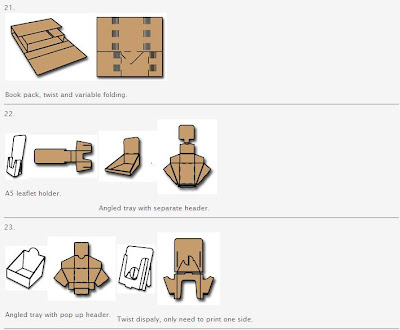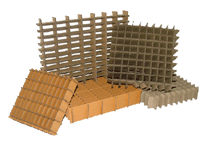What 3-D mapmakers should know about corrugated carton board and cartonboard
Corrugated board is made largely of recycled paper and most commonly comprises three components: an outer and inner “liner”, (the flat, surface components), and a “corrugating medium”, the “fluting”, which is glued between the liners It is this sandwich-type construction that gives corrugated board its excellent rigidity and structural strength as well as its unique cushioning characteristics.

Over the decades, corrugated board has evolved and developed to provide a wide range of products for different applications. Standard and non-standard categories of corrugated board are based on the type of flute, whether coarse, fine or extra fine and the number of fluted walls whether single, double or triple layered.
For the purpose of 3-D modeling, options include single face-, single wall – and double wall corrugated board, each of which can be made in a variety of weights and thicknesses.
The standard range includes the coarse ‘A’ and ‘C’ flute, fine ‘B’ and extra fine ‘E’ and ‘F’ flutes. The ‘B’ flute is the most widely used. It is very robust (difficult to crush) and has good compression strength. The ‘C’ flute is larger with greater compression strength but offers less crush resistance and requires more space.

Single face corrugated board is manufactured in standard widths ranging from 56” to 36”. It is easily transported in rolls. Its ability to withstand compression (an important factor for the stability of a 3-D model) is determined by the quality and thickness of the liner and the corrugating medium. For 3-D modeling, the liner and the corrugating medium should be at least 185 g/m2 and 150 g/m2 respectively. The best solution is to request a specially manufactured corrugated board making use of a liner (175 - 185 g/m2) and a kraft liner (175 –185 g/m2).
The thickness of corrugated board (an important dimension in respect of scaling 3-D models) is conventionally measured as detailed in the Table below.
If transport is not a constraint, you may wish to consider procuring single or double wall corrugated board, making sure that you get the best possible quality in terms of strengths as discussed above.
Provided you order a minimum quantity, depending on the goodwill of the manufacturer, corrugated board sheets can be cut to the desired size ahead of the modeling exercise.
In this case, the size of the board should possibly match that of the base table and the base map.

Single and double-wall corrugated boards are classified as detailed in the Table below and offer additional resistance to compression.

The choice between the various media will depend on their availability or readiness of manufacturers to produce them according to the desired specifications and to the transport facilities available to you to haul the material to where the model will be assembled. Rolls of board are easier to transport, as they can easily fit into the back of a pick up. Large carton board sheets are necessarily placed on the roof of a vehicle or in a truck you may want to get for the purpose.
iapad.org

































